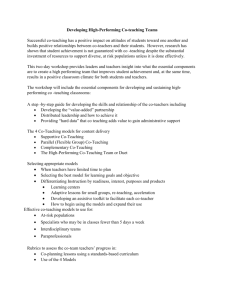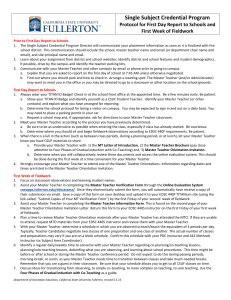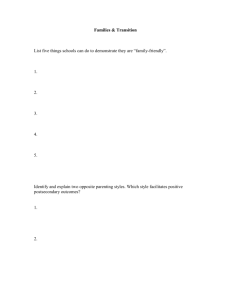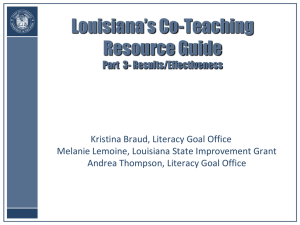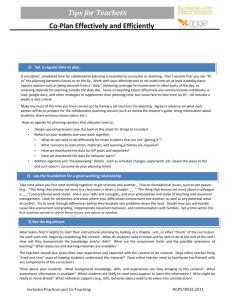Projected - WordPress.com
advertisement
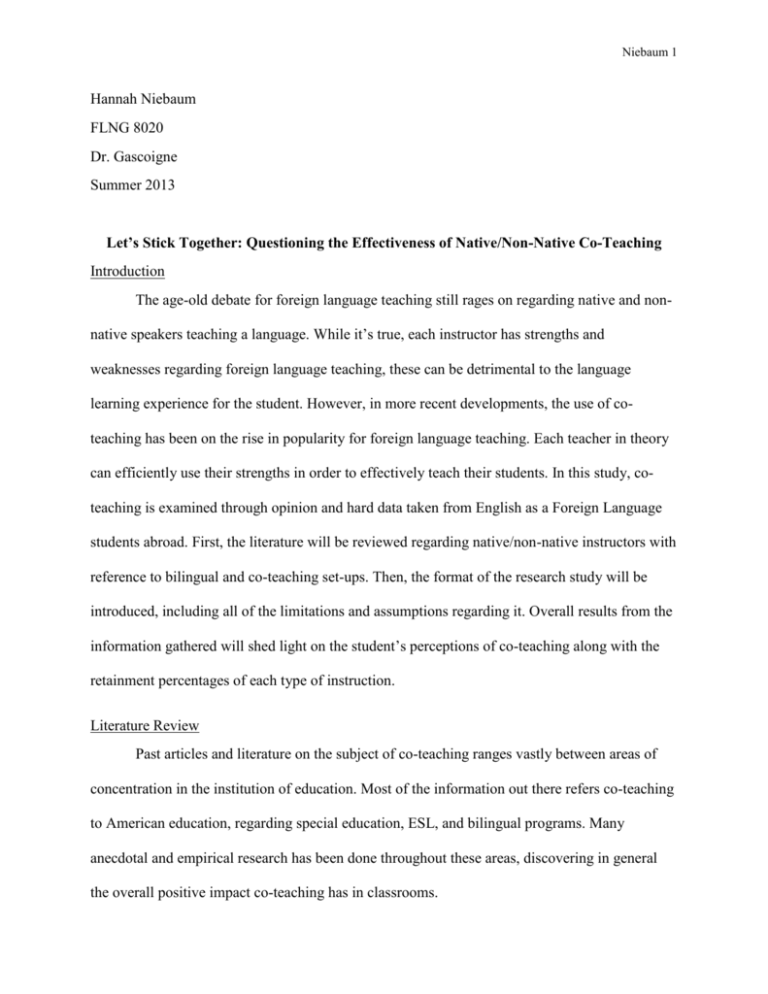
Niebaum 1 Hannah Niebaum FLNG 8020 Dr. Gascoigne Summer 2013 Let’s Stick Together: Questioning the Effectiveness of Native/Non-Native Co-Teaching Introduction The age-old debate for foreign language teaching still rages on regarding native and nonnative speakers teaching a language. While it’s true, each instructor has strengths and weaknesses regarding foreign language teaching, these can be detrimental to the language learning experience for the student. However, in more recent developments, the use of coteaching has been on the rise in popularity for foreign language teaching. Each teacher in theory can efficiently use their strengths in order to effectively teach their students. In this study, coteaching is examined through opinion and hard data taken from English as a Foreign Language students abroad. First, the literature will be reviewed regarding native/non-native instructors with reference to bilingual and co-teaching set-ups. Then, the format of the research study will be introduced, including all of the limitations and assumptions regarding it. Overall results from the information gathered will shed light on the student’s perceptions of co-teaching along with the retainment percentages of each type of instruction. Literature Review Past articles and literature on the subject of co-teaching ranges vastly between areas of concentration in the institution of education. Most of the information out there refers co-teaching to American education, regarding special education, ESL, and bilingual programs. Many anecdotal and empirical research has been done throughout these areas, discovering in general the overall positive impact co-teaching has in classrooms. Niebaum 2 The specific research of native vs. non-native speaking instructors is also vast, which adds extra information for co-teaching since there is one of each teacher in the dynamic duo. Most literature on the debate of which instructor is better in the foreign language education system varies, but most recently it has come to a general consensus that each teacher has his/her own strengths when teaching a foreign language. The non-native speaker is better at the fundamentals, like grammar, while staying empathetic, seeing as these teachers also have gone through the process of L2 acquisition. The native speaker is better at pronunciation, vocabulary, and cultural information, but generally tend to teach the more advanced language speakers. These general perceptions were found in the study conducted by Dr. Tammy Hertel and Dr. Gretchen Sunderman in the article Student Attitudes Toward Native and Non-Native Language Instructors (2009). Teachers of course always have a different point of view than the students, and it is no different with the co-teaching method. Teachers interviewed in Vance Austin’s Teachers’ Beliefs About Co-Teaching showed some general conclusions regarding co-teaching in various fields, like general education and Special Education. These teachers all generally thought that the general education instructor (in my case the non-native instructor) was believed to conduct more teaching than the other instructor (the native speaker for my study). Even in the United States, this perception runs horizontal among the groups divided in the education institution. Even if this is not true, most think of the second teacher (whose role is more specific in nature) to be more of a ‘helper’, not a collaborator (Pappamihiel, 2012). What seems to be unanswered or a current problem regarding co-teaching is the absence of the actual stakeholders involved: the co-teachers. Boards of Education across the country try to implicate these methods of teaching, while the actual instructors are found scrambling and Niebaum 3 picking up the pieces of the poorly planned transitions. Constant communication with all players involved, such as administrators, students, parents, para-professionals, etc. are all an integral part of the co-teaching process (Dove, 2012). The general overview of co-teaching (listing non-specific modes of instructors) was the closest I could come to finding information on co-teaching abroad English as a Second Language. Much last the proceeding article discussed the factors involved in co-teaching, including the importance of collaboration and involvement from all parties. Well in the article by Marilyn Friend titled Co-Teaching: A Simple Solution That Isn’t Simple After All, discusses some deciding, and sometimes negative, factors regarding co-teaching and emphasizes the complexity that co-teaching can become. Having extra time outside of the classroom to co-plan, maintain a positive learning environment, designating responsibilities, and administrative support can be challenging factors for co-teaching. So overall, the literature on co-teaching focuses mainly on American education system, but the factors and considerations for co-teaching in this country can definitely be applied to working overseas. Most modern day education systems are fairly similar and abroad there may be the same issues co-teachers face in the United States. Debunking common myths and facing facts, this literature helped round out and predict a conclusion for this ‘unfinished’ research study. Of course, there will be significant differences abroad, but general teaching methods and ideals are assumed to be common abroad as well. I would like to know the real outcome of this research project so I can compare abroad opinion with homeland prerogatives! Current Study The current study will contain one class of students, roughly the average size (ranging from 15-30 students approximately). These students are all roughly the same proficiency level, Niebaum 4 with prior teaching and experience with learning English as a foreign language. It will be a cogendered class and of course, be learning the target language in their native country/ancestral home. Examples like this could include Korea, Argentina, France, etc. – anywhere English is not the dominant language. Dependent variables range from educator ability, the use of the same two teachers in the study, or the amount of time each section is taught by each combination of instructors. Questions for the research study are: How effective is foreign language co-teaching abroad? What perceptions do students have regarding native, non-native, and co-teacher taught classrooms? Research regarding co-teaching abroad was almost little to none, but the amount of research regarding English language learning in the United States led to the conclusion that coteaching is a collaborative process with a great deal of strategy and teacher application involved. This leads to the belief that co-teaching will be very effective for the foreign language students, resulting in higher tests scores and better oral communication in the target language. Student perception of co-teaching with English as a second language as the subject was dampening, but other areas of co-teaching student perception, such as special education and ELL in the United States shows an overall positive outcome towards the co-teaching aspect. Hypothesizing the similarities between these student groups, I am concluding that students will find the co-teaching to be more helpful and rewarding for them. This will also be shown through the analysis of their grades, comparing the single teaching by each instructor to the last choice of the final co-teaching method. Method Participants for this study are all middle school students ranging from the ages 13 to 15 years old. They are non- native speakers of English, but with previous language instruction in Niebaum 5 English. These students also are enrolled in their mandatory allotted time of English as a Foreign Language course. Ideally, one class would be used over the course of the study so that accurate results can be acquired to support the questions asked. The participants are co gendered, hopefully balancing out at an even number. For later and/or more of a data pool, multiple middle school classes across a district would be included in the study, if resources and cooperation is available. A pre/post questionnaire will be provided at the start of the study and at the conclusion of the study to gather a general perception of students’ opinions on their preferred instructor method of teaching; native only, non-native only, or native/non-native co-teaching method. A series of six questions and a comments section at the end will be on the survey, the first three asking which instructor had the most effective teaching on a scale of one to ten (Native Speaker/NonNative Speaker/Both) and the following three asking in general the student’s preferred instructor/combination on a scale of one to ten, one being the worst and ten being the best (NS/NNS/BO). The conclusion of the survey will have a comments section just as a catch all for students wish to clarify answers or have general comments about an instructor. Also accompanying the survey will be an overall retainment data analysis, quantifying quizzes/test scores and observation from the students on their general learning from each instructor/method. Over the course of three separate sections, differing in English material, the varying educator methods will be divided, beginning with the non-native speaking teacher, followed by the native speaker instructor, than concluded with the two co-teaching the material together. Throughout each section, there will be weekly quizzes, unit tests, and general observation by the instructor(s) at the amount of material successfully retained by the instructing Niebaum 6 method. At the end of the study, this data will be analyzed and charted as to effectively compare the most efficient possible way for this type of age group to learn the English language! Influential Factors Although this study seems to be well set-up, when working with the human element and certain circumstances, there are always limitations, assumptions, and influential factors made or known about the study group to take into consideration. As factors to consider for the study, there should be an awareness of the time of year the material is being taught like for example, if there is a national holiday, political event affecting the country, problems at home/social circle for the student, and these outside influential factors could change the students’ attitudes and motivation for learning in the classroom setting. Assumptions regarding the study are that the two instructors are competent educators, preferably at the same ‘level’ of teaching, if there is such a value to be placed on educators. There are no transferred in/out students from the class, thus skewing the data. The class will be held in the same classroom at the same time every class period for the subject so students have a uniformity of some kind. Limitations for this study are numerous just because of the nature of the study. This ideal study is set up so that these instructors do have the permission and cooperation from the school, parents, students, and other staff to follow through with the study. Most instructors do not have such freedom to do so, but in an ideal world or maybe in the near future, this study can be possible so as to gain this useful information in developing co-teaching curriculum and methods. A large limitation for this study also could include that the pair of instructors did not previously know each other or did not pick to be paired together. If the personalities of these teachers conflict, it will affect the co-teaching segment of this study, which is possibly the most important part of this study. Another limitation to this study is the possibility of the material’s difficulty Niebaum 7 differing between the instructor(s) section. Following the content’s flow, one instructor’s section might be more difficult to teach, be harder to retain by the students, or differ in length than the other sections taught by the other instructor(s). This would change the results drastically and skew the data for the study if student’s base their experiences on the material being taught alone. Teaching material that better corresponds to the instructor(s) strengths seems like common sense, but the overall goal of this study is to find, in general, what instructing method best teaches this age group of students in English. The goal is to not find what instructing method best fits which material regarding the English language. Projected Results The projected results are all speculation, based on corresponding literature, studies, and educated guess, regarding the study. For the pre/post general study questionnaire, I predict the students will enjoy learning from the co-teaching method. These reasons could range from familiarity with the instructors previously, so they are already comfortable learning with these instructors or because the students feel that they have more help or resource from both instructors at the same time, feeling like their learning environment is being enhanced. There may be some favoritism towards one or the other instructor based solely on the student’s personal preference, not because of the material learned, but with any questionnaire there should be these considerations. Data analysis from test scores and quizzes might also prove favoritism towards coteaching based alone on the extra resource and knowledge from both teachers’ presences. However, if the class’s general knowledge is low of the English language, there is a chance of the non-native instructor’s results being higher, given under the assumption that the instructor is teaching in the native language, not the target language of English. However, a consideration to Niebaum 8 be made that would contradict this theory is that teaching English abroad with native speaking teachers tends to be more of a relaxed and positive learning environments, using games and hands on activities to learn as opposed to traditional teaching methods. These fun inducing activities may cause for better retainment because of the positive experience rather than sole memorization. So overall, comparing student preferences and mainly empirical data, the conclusion I can assume is that the students will prefer and benefit from the co-teaching method. With their general education teacher (non-native speaker) paired with the visiting English teacher (native speaker) benefit from the strengths of the NS/NNS instruction. These instructors have also created a safe and comforting educational environment for the students by previously teaching them for those two separated sections of material. Random factors like preconceived notions of NS vs. NNS held by the students could also create the possible results for this current study. Conclusion In conclusion, this research project pursued the question “Is co-teaching abroad a foreign language affective?” This question arose other questions, such as ‘Which age groups is coteaching ideal for?’ and “Can/Does class duration affect the co-teaching method?’ All signs point to yes, from previous research studies, journal articles, and general educated guesses after developing an academic educational background. Although in theory, co-teaching is extremely ideal there are numerous influential factors that are involved when co-teaching, as seen in the literature review. Collaboration and communication are key to creating a successful co-teaching partnership. However, to prove these general theories regarding co-teaching, I have developed a current study that involves a questionnaire and empirical data section. In the pre/post Niebaum 9 questionnaire, students’ perceptions on the various ways a foreign language is taught (NS/NNS/BO) will be identified from the participants group. Then the analysis of quiz/test scores and observations from the instructor will track retainment by the students. After the study is concluded, all the data will be analyzed, the instructor(s) with the best identified data will be shown as the most effective way of teaching. Projected results all point to co-teaching, as there are great positive claims regarding the method. Co-teaching is more common amongst English as a second language and Special Education in the United States, but abroad is works similar to the English as a second language does here, except that specifically for an allotted time, teaching is devoted to let students learn English, not just having an ESL instructor aid in general education. Unfortunately, there are a plethora of limitations and assumptions this study holds, but its intentions are ideal and pure. All in all, co-teaching seems to require great effort from the instructors, but in the end with the proper planning and communication, it can be one of the most effective methods of teaching. It is already somewhat implemented in language acquisition not just in ESL, but in bilingual programs across the globe. The gradual removal of the non-native speaking instructor and the gradual introduction of the native speaking instructor, with most of the overlap occurring in the middle, I believe is to be the most effective way of learning a second language or one’s heritage language effectively. Some parts in Canada have programs similar to this, teaching French/English by incorporating them into the general education material. Certain subjects are taught in certain languages and it all seems highly successful. Maybe in the future, if these kinds of programs are adopted by more of the global population, more languages would be spoken! Niebaum 10 References Austin, Vance L. "Teachers' Beliefs About Co-Teaching." Remedial and Special Education 22.4 (2001): 245-55. JSTOR. Web. Dove, Maria G. "Chapter 4: Grassroots Approach to Co-teaching for English Language Learners." Breaking the Mold of School Instruction And Organization: Innovative and Successful Practices for the Twenty-first Century. 25-31 p. Web. Friend, Marilyn. "Co-Teaching: A Simple Solution That Isn't Simple After All." Journal of Curriculum and Instruction 2.2 (2008): 9-19. JSTOR. Web. Hertel, Tammy Jandrey, and Gretchen Sunderman. "Student Attitudes Toward Native and NonNative Language Instructors." Foreign Language Annals 42.3 (2009): 468-82. JSTOR, Web. Pappamihiel, N. Eleni. "Benefits and Challenges of Co-teaching English Learners in One Elementary School in Transition." The Tapestry Journal 4.1 (2012): 1-13. Web. Wallace, Michael J. Action Research for Language Teachers. Cambridge: Cambridge UP, 1998. Print.


